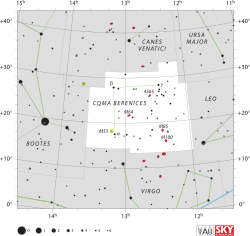Coma Berenices
| Constellation | |

|
|
| Abbreviation | Com |
|---|---|
| Genitive | Comae Berenices |
| Pronunciation |
/ˈkoʊmə bɛrəˈnaɪsiːz/, genitive /ˈkoʊmiː/ |
| Symbolism | Berenice's hair |
| Right ascension | 11h 58m 25.0885s–13h 36m 06.9433s |
| Declination | 33.3074303°–13.3040485° |
| Family | Ursa Major |
| Area | 386 sq. deg. (42nd) |
| Main stars | 3 |
|
Bayer/Flamsteed stars |
44 |
| Stars with planets | 5 |
| Stars brighter than 3.00m | 0 |
| Stars within 10.00 pc (32.62 ly) | 1 |
| Brightest star | β Com (4.26m) |
| Nearest star |
β Com (29.78 ly, 9.18 pc) |
| Messier objects | 8 |
| Meteor showers | Coma Berenicids |
| Bordering constellations |
Canes Venatici Ursa Major Leo Virgo Boötes |
|
Visible at latitudes between +90° and −70°. Best visible at 21:00 (9 p.m.) during the month of May. |
|
Coma Berenices is an ancient asterism in the northern sky which has been defined as one of the 88 modern constellations. It is located in the fourth galactic quadrant, between Leo and Bootes, and is visible in both hemispheres. It was introduced to Western astronomy during the third century BC by Conon of Samos. Its name means "Berenice's Hair" in Latin and refers to Queen Berenice II of Egypt, who sacrificed her long hair as a votive offering to Venus. Coma Berenices is the only modern constellation named for an historic figure. It was further corroborated as a constellation by Gerardus Mercator and Tycho Brahe.
Three of the constellation's stars are visible to the naked eye: Alpha Comae Berenices, Beta Comae Berenices and Gamma Comae Berenices. They form a 45-degree triangle, from which Berenice's imaginary tresses hang. The constellation's brightest star is Beta Comae Berenices, a 4.2-magnitude main sequence star similar to the Sun. Coma Berenices contains the North Galactic Pole and one of the richest known galaxy clusters, the Coma Cluster, part of the Coma Supercluster. Galaxy Malin 1, in the constellation, is the first known giant low-surface-brightness galaxy. Supernova SN 2005ap discovered in Coma Berenices is the brightest known, and SN 1940B was the first observed example of a type II supernova. The star FK Comae Berenices is the prototype of an eponymous class of variable stars. The constellation is the radiant of one meteor shower, Coma Berenicids, which has one of the fastest meteor speeds, up to 65 km/s (40 mps).
...
Wikipedia
